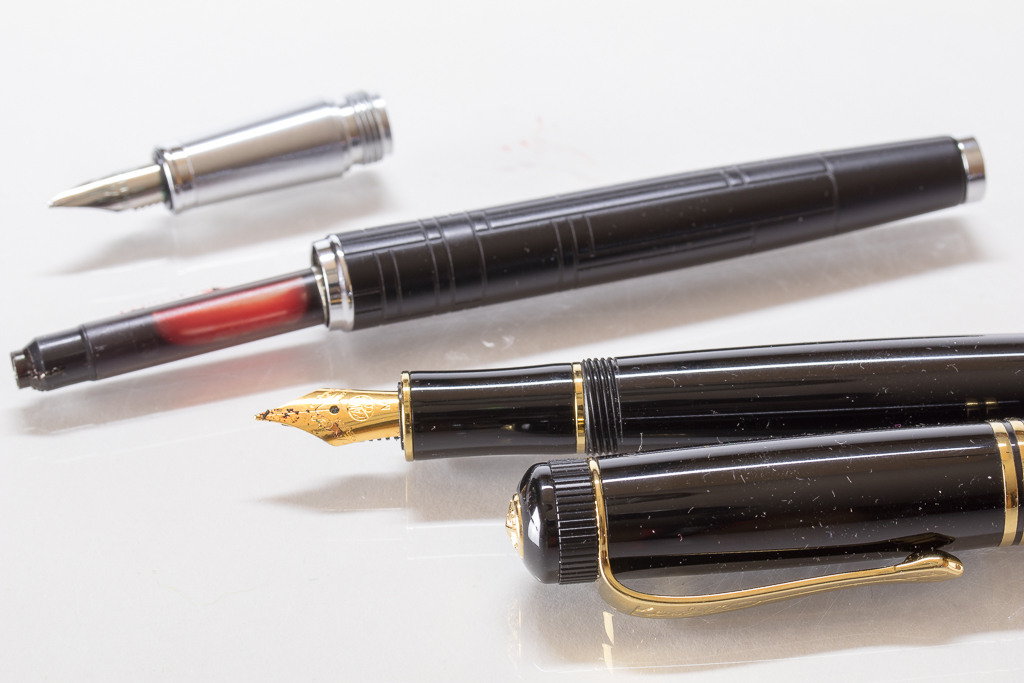
Having a leaky pen is one of the most frustrating problems that a fountain pen enthusiast can have! But equally as annoying is bad ink flow. It’s happened to me, a few customers and it’s bound to happen to you at one time or another. Your perfect pen ceases to write the way it used to and it becomes relegated to the bottom drawer.
All they need is a little tender love and care.
You could purchase metal shims to widen the gap between the tines or invest in a loupe and be paranoid about tine or feed alignment. There are any number of ways to bend and fix your nib to get the ink flow you previously had but there are a few things to look for before you man-handle your nib.
1) Dirt: Admit it! You’re a little bit lazy and don’t keep a regular cleaning schedule? I know I am! Have you ever looked at your nib and seen dried ink on the top or refilled the converter without flushing it first? Many common ink flow problems can be cured with a quick clean of your fountain pen. We recommend you read our quick guide on cleaning your fountain pen as the first stop to getting better ink flow.
2) Disconnected ink supply: As funny as it sounds I’ve dropped my pen on a number of occasions and dislodged the cartridge without realizing it. Everything works just fine when the ink supply is firmly connected but when disconnected and the ink in the nib runs out, you will get ink flow issues! Take a moment to open up your pen to make sure your cartridge or converter haven’t been knocked away from the feed.

3) An upward pointing nib: Another common reasons why ink can stop flowing is that the pen is carried with the nib pointing upwards. This is actually the recommended way to carry your fountain pen to stop little messes happening, but if done so for extended periods you might find that ink drains out of the feed and cuts off flow. Store your pen with the nib facing down for a little while to see if the flow returns.
4) Paper: Believe it or not, paper really makes a difference! Make sure you use a good paper that is fountain pen friendly. You will likely find poor ink flow on paper that is less than ideal. This is especially true if your nib is a fine point. Be mindful when you have used a paper that isn’t fountain pen friendly. It’s possible that microscopic paper flakes can get caught in the tines and block flow. Flushing your pen will often cure this problem.
5) Ink: Did you know that some ink runs dry and some runs wet? Not all ink is made equal. For example we find most Noodler’s ink to run a little thicker and drier compared to Waterman or Diamine. Where broader nibs are more forgiving, fine nibs can cause a problem. Remember also that ink colours contain different quantities of dyes and chemicals. Ink can also vary even when they are from the same manufacturer. A quick solution to altering ink consistency is to add just a touch of water to your cartridge or converter. The easiest way to do this is via a blunt syringe but if you are agile you can also suck a little water into the system in the same way as you do when you are filling your pen.
6) Capillary action: Dipping the nib in a little water can often start the unique capillary action of a fountain pen that draws ink from your converter or cartridge to the paper. But remember if you have to trigger the capillary action then the chances are you need to flush your pen!
7) Tines: If you are still not seeing ink flow then draw the nib toward you with a slight amount of pressure on a good fountain pen paper. Widen the tines just a bit using this pressure to see if the ink flows.
Go to a pro! If you still have unsatisfactory ink flow then hire a pro! It’s one thing to use a shim in a lower cost pen such as a Noodler’s Ink flex pen to widen tines – you are encouraged to tinker with your pen – we don’t recommend you try to fix a branded pen yourself unless you really know what you are doing. Many manufacturers offer maintenance services and may be the best way to fix your flow.